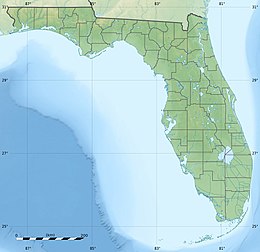
Back Anastasia Island (pulo sa Tinipong Bansa) CEB Isla Anastasia Spanish Anastasia Island French Pulau Anastasia ID Pulo Anastasia JV 安娜斯塔西亞島 ZH-YUE
 View of Anastasia Island from St. Augustine Lighthouse. | |
| Geography | |
|---|---|
| Location | North Atlantic |
| Coordinates | 29°48′15″N 81°16′01″W / 29.80406°N 81.26692°W |
| Administration | |
| State | Florida |
| County | St. Johns |
Anastasia Island is a barrier island located off the northeast Atlantic coast of Florida in the United States. It sits east of St. Augustine, running north–south in a slightly southeastern direction to Matanzas Inlet. The island is about 14 miles (23 km) long[1][2] and an average of 1 mile in width. It is separated from the mainland by the Matanzas River, part of the Intracoastal waterway. Matanzas Bay, the body of water between the island and downtown St. Augustine, opens into St. Augustine Inlet.
Part of the island (the Davis Shores and Lighthouse Park neighborhoods) is within St. Augustine city limits, while other communities on the island include St. Augustine Beach, Coquina Gables, Butler Beach, Crescent Beach, and Treasure Beach.
Fort Matanzas National Monument, a Spanish colonial-era fort built in 1740–1742,[3] is located at the southern end of the island[4] on Rattlesnake Island in the Intracoastal waterway within the park boundaries;[5] it was designed to protect St. Augustine from attack via the Matanzas River.
- ^ Charles Ledyard Norton (1892). Handbook of Florida. Longmans. p. 175. Retrieved 10 August 2013.
- ^ Orrin H. Pilkey (January 1984). Living with the East Florida Shore. Duke University Press. p. 77. ISBN 978-0-8223-0515-6. Retrieved 11 August 2013.
- ^ Richard R. Henderson; International Council on Monuments and Sites. U.S. Committee; United States. National Park Service (March 1989). A Preliminary inventory of Spanish colonial resources associated with National Park Service units and national historic landmarks, 1987. United States Committee, International Council on Monuments and Sites, for the U.S. Dept. of the Interior, National Park Service. p. 87. ISBN 9780911697032. Retrieved 2 May 2013.
- ^ United States. Office of Archeology and Historic Preservation; Luis R. Arana (1967). Castillo de San Marcos National Monument ... and Fort Matanzas National Monument ...: historical research management plan. p. 24. Retrieved 11 August 2013.
- ^ The Code of Federal Regulations of the United States of America. U.S. Government Printing Office. 1957. p. 187. Retrieved 11 August 2013.

